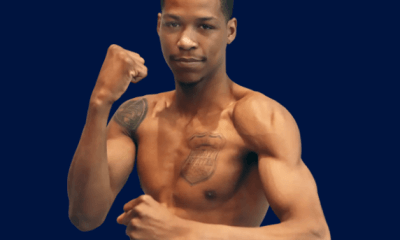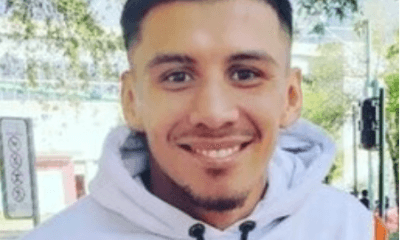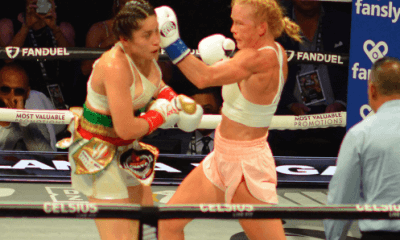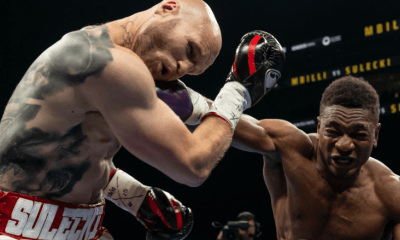Featured Articles
For Whom the Bell Tolled: 2021 Boxing Obituaries PART TWO (July-Dec.)
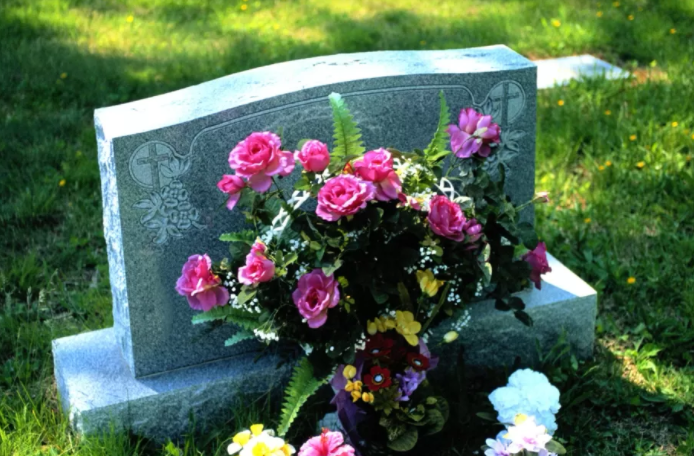
Here is the second and final installment of our annual year-end report in which we pay homage to those for whom the final bell tolled.
July
2 – Lehlo Ledwaba – He won the IBF 122-pound title in 1999 and made five successful defenses before losing the belt on a sixth-round stoppage to Manny Pacquiao in what was Pacquiao’s U.S. debut. He trained and managed several fighters after leaving the sport with a record of 36-6-1. At age 49 of Covid complications at a medical clinic in his home province of Soweto, Johannesburg, South Africa.
12 – Conroy Nelson – According to various sources, Nelson spent the last 20 years of his life living in a bamboo hut with no electricity on a family farm in his homeland of Jamaica. Fighting out of Canada, he compiled a 21-24-2 record during a 20-year career during which he was fodder for the likes of Mike Tyson, Herbie Hyde, and Riddick Bowe. He was battling pancreatic cancer when he died of a heart attack at age 62.
22 – Andre Thysse – From the Gauteng province of South Africa, Thysse answered the bell for 221 rounds during a 10-year career that began in 1999. He finished 20-8, but was stopped only twice and reportedly never knocked down. In retirement, he owned several businesses and promoted a few fights in Johannesburg. At age 52 of Covid-19.
August
10 – Stanley “Kitten” Hayward – He was right in the thick of things when Philadelphia was a hornets nest of rugged welterweights and middleweights and had one crack at the 154-pound world title, losing a 15-round decision to underrated Freddie Little in Little’s adopted hometown of Las Vegas. After leaving the sport with a 32-12-4 record, he spent 33 years as a Court Crier in Philadelphia where he died from complications of a stroke.
21 – Jarvis Astaire – A Hall of Fame boxing promoter with a wide range of business interests, he was the man most responsible for bringing U.K. boxing into the closed circuit and pay-per-view age. The Astaire Alliance, which included matchmaker Mickey Duff, ruled British boxing with an iron thumb for decades beginning in the late 1960s. At age 97 in London.
23 – Giovanni Pretorius – A former OIympian, the heavy-handed Johannesburg bomber challenged Robin Reid for the WBC super middleweight title in 1997, succumbing in seven rounds. He finished 28-2-1 (24). At age 49 in a hospital in Alberton, S.A., a victim of Covid.
September
1 – Jeanette Zacarias – Only the second known female ring fatality following South Africa’s Phindile Muelas (2014), Zacarias collapsed after the fourth round of an Aug. 28 bout in Montreal and died four days later without regaining consciousness. It was her sixth pro fight. A native of Aguascalientes, Mexico, she was only 18 years old.
2 – Doyle Baird – A brawler from Akron, Ohio who turned pro at age 28, Baird turned heads in 1968 when he held middleweight champion Nino Benvenuti to a draw in a non-title fight. Benvenuti stopped him in 10 rounds in the rematch. He went on to challenge Vincente Rondon for the light heavyweight title (L TKO 6) and retired with a record of 34-7-1. At age 83 in Akron.
10 – Manuel Calvo – Fighting almost exclusively in Spain, Calvo compiled a 54-18-6 record in a 12-year career that began in 1963. Both he and his son of the same name won European featherweight titles. At age 79 in Madrid where he was battling a heart condition.
October
9 – Keitaro Hoshino – Active from 1988 to 2003, Hoshino engaged in six world title fights in the smallest (105 pound) weight class and was a two-time world title-holder. He finished 23-10, somewhat misleading as he was on the wrong end of several razor-thin decisions. At age 52 in his native Yokohama after a long but unspecified illness.
11 – Tony DeMarco – Born Leonardo Liotta, DeMarco won the world welterweight title in 1955 with a 14th-round stoppage of Johnny Saxton, but lost it 10 weeks later in the first of his two sizzling matches with Carmen Basilio. Ushered into the IBHOF in 2019, he finished 58-12-1. An impressive bronze statue of him sits near his boyhood home in Boston where he died at age 89.
31 – Tommy Thomas – Born and raised in Clarksburg, West Virginia, Thomas compiled a 34-8 record during a 10-year career that began in 1977. He tangled with the likes of Michael Dokes, Leon Spinks, and Pierre Coetzer. In retirement, he worked as a police officer in Clarksburg and ran a boxing gym. At age 67 after a long battle with Parkinson’s and dementia.
November
4 – Jerry Martin – Born and raised in Antigua, Martin, nicknamed “The Bull,” turned pro in Philadelphia in 1976 without the benefit of any amateur experience and compiled a record of 25-7. He went inside Rahway prison walls to upend inmate James Scott in a big upset on NBC, but failed in three cracks at the world light heavyweight title, losing to Eddie Mustafa Muhammad, Matthew Saad Muhammad, and Dwight Muhammad Qawi. At age 67 in Philadelphia of an undisclosed illness.
6 – Steve Lott — A protégé of the noted boxing historian and memorabilia collector Jim Jacobs, Lott was swept into the world of boxing when Jacobs and his business partner Bill Cayton took to managing prizefighters. Closely allied with the young Mike Tyson, he handled the daily affairs of several other world champions and went on to curate a vast library of boxing ephemera at the popular website Boxing Hall of Fame Las Vegas. At age 71 in a Las Vegas hospital after suffering a head injury in a fall at his home.
9 – Loucif Hamani – Hamani turned pro in Paris after representing Algeria in the 1972 Munich Olympics and compiled a record of 24-3. He out-pointed a faded Emile Griffith, but was no match for Marvin Hagler who wacked him out in the second round in his lone U.S. engagement. At age 71 in Paris after a long illness.
13 – Jeff Wald – A powerful Hollywood talent agent whose clients included Sylvester Stallone, Wald was the co-creator and co-executive producer of “The Contender” series and had a financial stake in George Foreman’s last two fights. At age 77 in Los Angeles.
17 – Johnny Gant – A welterweight contender in the 1970s who finished 45-15-3, Gant battled such notables as Esteban De Jesus, Hedgemon Lewis, Hector Thompson and Sugar Ray Leonard and went 15 rounds with Angel Espada in Puerto Rico in a failed bid for Espada’s world title. In retirement, the Washington DC native founded a boxing academy in Atlanta for at-risk youth. At age 70 of an undisclosed illness.
17 – Johnny Sarduy – The Cuban featherweight, who finished 33-7-4, closed out his career with two fights in Miami Beach, the second of which included Cassius Clay on the undercard. Sarduy left boxing to join the anti-Castro, CIA-sponsored “Bay of Pigs” invasion and in retirement became a wealthy drywall contractor. At age 85 in Miami.
23 – Paul Cardoza – A two-time New England Golden Gloves champion who served in the Navy and the Marines, Cardoza, a light heavyweight, was 23-9 as a pro in a seven-year career that began in 1969. He split two fights with two-time world title challenger Richie Kates and hung up his gloves after getting stopped by future belt-holder Marvin Johnson. At age 78 in New Bedford, MA, where he was a lifelong resident.
December
13 – Gaspar Ortega – A staple on the small screen during the golden age of TV boxing, the colorful, iron-chinned Ortega, part Zapotec Indian, had 176 documented fights, finishing 131-39-6, and remarkably was stopped only twice, the first coming in 1961 in a failed bid for Emile Griffith’s world welterweight title. The father of world class referee Mike Ortega, “El Indio,” a longtime Connecticut resident, passed away at age 86 at the home of his daughter in Naples, Florida.
14 – Tony Perez – He refereed dozens of world title fights beginning with Joe Frazier vs. Jimmy Ellis on Feb. 16, 1970, and including Muhammad Ali’s first post-exile fight against Jerry Quarry later that year. At age 90 in Barnegat Township, New Jersey. His survivors include his wife Barbara, a former boxing judge who likewise worked many championship fights.
24 – Danny Kelly Jr – A 30-year-old heavyweight with a 10-3-1 record, Kelly was fatally shot in an apparent road rage incident while driving with his girlfriend and three young children on a busy roadway in Saint George County, Maryland, late in the afternoon on Christmas Eve. None of the other occupants of the vehicle were injured. His assailant remains at-large.
28 – Harry Reid – A five-term U.S. Senator from Nevada and the Senate Majority Leader from 2007 to 2015, Reid was an amateur boxer who officiated at approximately 100 pro fights as a ringside judge. He introduced legislation to strengthen the Muhammad Ali Boxing Reform Act and was named to the Nevada Boxing Hall of Fame for his contributions to the sport. At age 82 in Henderson, NV, after a four-year battle with pancreatic cancer.
Check out more boxing news on video at the Boxing Channel
To comment on this story in the Fight Forum CLICK HERE
-

 Featured Articles3 weeks ago
Featured Articles3 weeks agoAvila Perspective, Chap. 330: Matchroom in New York plus the Latest on Canelo-Crawford
-

 Featured Articles1 week ago
Featured Articles1 week agoVito Mielnicki Jr Whitewashes Kamil Gardzielik Before the Home Folks in Newark
-

 Featured Articles4 weeks ago
Featured Articles4 weeks agoAvila Perspective, Chap 329: Pacquiao is Back, Fabio in England and More
-

 Featured Articles3 weeks ago
Featured Articles3 weeks agoOpetaia and Nakatani Crush Overmatched Foes, Capping Off a Wild Boxing Weekend
-

 Featured Articles2 weeks ago
Featured Articles2 weeks agoCatching Up with Clay Moyle Who Talks About His Massive Collection of Boxing Books
-

 Featured Articles3 weeks ago
Featured Articles3 weeks agoFabio Wardley Comes from Behind to KO Justis Huni
-

 Featured Articles1 week ago
Featured Articles1 week agoMore Medals for Hawaii’s Patricio Family at the USA Boxing Summer Festival
-

 Featured Articles4 weeks ago
Featured Articles4 weeks agoDelving into ‘Hoopla’ with Notes on Books by George Plimpton and Joyce Carol Oates

